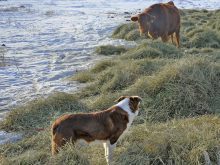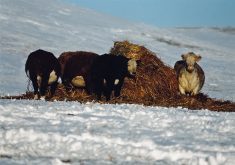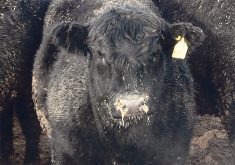The source of bovine tuberculosis found in six Alberta cattle last year may never be found.
It’s a perplexing aspect to a situation that affected many ranchers in Alberta’s southeastern region near Jenner and Saskatchewan ranchers along the nearby provincial border.
Approximately 11,500 animals have been killed to ensure eradication of the disease, and another 17,500 have been released from quarantine since the start of the Canadian Food Inspection Agency’s response.
Almost all animals that left the index herd have been traced, tested and dealt with, but it’s still a mystery how a cow from southeastern Alberta contracted TB and was confirmed with the illness after being shipped to a U.S. packing plant.
The route to potentially solving that mystery is a catch-22, said Karin Schmid, beef production specialist with Alberta Beef Producers.

“We would all really like to know where it came from, and another positive might give us some more information to that end,” she said.
“But then it starts the cycle all over again, right? So that new herd would then have to be investigated with trace-outs and trace-ins and direct contacts and fence-line contacts, and all of those other animals and other producers could potentially be affected, and I don’t think that’s a situation we want to be in either.”
Failure to identify the source in cases of bovine TB is not unusual, Schmid added.
For example, 2011 discovery of the illness in British Columbia cattle did not lead to any identification of the source.
Read Also

Beef check-off collection system aligns across the country
A single and aligned check-off collection system based on where producers live makes the system equal said Chad Ross, Saskatchewan Cattle Association chair.
In last year’s case, many ranchers saw their herds destroyed and their incomes and activities drastically affected by the CFIA’s TB eradication efforts.
Only recently have some begun to buy cattle and rebuild their herds, after a disinfection process and fallow period during which no animals were present on affected areas of their premises.
Those who have restocked will have their stock re-tested in coming months to ensure absence of the disease.
The CFIA’s latest report indicates 10 premises are still under quarantine and 96 have been released from quarantine.
The agency’s numbers are somewhat confusing, noted Schmid, because they don’t refer to specific ranch operations but rather to pastures or even parts of pastures where potentially affected cattle once lived.
Work still remains on trace-ins, which are cattle that entered the index herds. The CFIA has identified 80 premises to be tested and is working with owners to manage that at a convenient time. Those operations will not be quarantined until testing begins.
“Basically (operations with trace-ins are) considered the same risk as all the other cattle in Canada because ideally, if it was simmering away in another herd, our surveillance at slaughter should have caught it,” said Schmid.
“The process is a little different for the trace-in herds. When we’re in the infected and trace-out, those higher risk cattle, we were trying to spread the net as wide as we could to make sure we didn’t miss anything.
“The testing process that we’re going to use on the trace-in cattle, (we want to) make sure that we narrow down the number of false positives so that hopefully not very many producers will have to actually go through the full culture process (and) be under quarantine for 14 weeks.”
Testing has shown that the strain of TB identified in the index Alberta herd is closely related to one first identified in Mexico in 1997.
That doesn’t necessarily mean there’s a Mexican connection, said Schmid. The same strain has been found in U.S. cattle.
“Just because it was first identified in Mexico does not necessarily mean that was the place the strain originated. We may have had it all along, (although) I don’t necessarily think that’s the case.”
Some Alberta ranchers in the affected region suspected tuberculosis spread to cattle from the large elk herd resident on Canadian Forces Base Suffield, but testing of elk killed on the base during hunting season found no traces of the disease.
Schmid said the CFIA and Alberta government are now collaborating on a strategy for TB surveillance in wildlife.

















